May is usually a time of great anticipation for McCarthy’s Party Tours. Though our travel season doesn’t officially start until June, we celebrate early arrivals with a gusto, welcoming specialty groups and conference travelers who are fortunate enough to experience the last of a wonderfully whimsical winter and this magical month of weather madness. Remember, Newfoundland & Labrador won’t see ‘Spring’ until June, and the interim brings a whole new meaning to ‘Mayday’ with some of the most incredible “weather” on the planet.
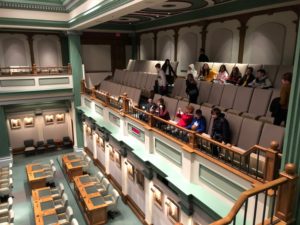
“… a true learning experience…”
Among our favorite May excursions is the annual retreat for a class of young film students from Toronto’s ‘York’ college. This is an especially talented group of children who expect a true learning experience while shooting the eastern component of a nation-wide documentary that starts in Newfoundland & Labrador. Guides embrace the opportunity, spending an inordinate amount of time preparing for this trip and the litany of questions the class present in an interview format that is recorded for submission and grading.
Thankfully, the school provides content requirements in advance, and together we plan a unique itinerary that best suits their ideals. Last year’s focus was on resource development; extraction, depletion, demise, and ultimately, the need for change and adaptation. So of course, we suggested a ferry ride to Bell Island with a stop at the mining museum.
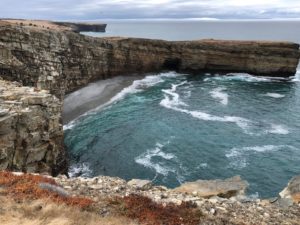
“… plan a unique itinerary…”
For many years, Bell Island boasted the largest iron ore mine in the world. A massive deposit that stretched many miles below the ocean in a well-defined structure that was conveniently located on a tide water port. The mine operated for almost 100 years, closing in 1967 when technological changes in the smelting industry deemed the ore unusable, leaving nearly 3 billion tons in the ground to this very day. This was a most unexpected turn of events; a major “disruptor” that resulted in the loss of over 2,400 jobs and devastated the community.
As you might expect, the mine tour focus’ mainly on this downturn, along with the many hardships of a miner’s life. The entire tale is one of hardship, impoverishment, and woe – an unfortunate manifestation we tend to create in our “Oral History”. Even when undeniable accounts of archaeological evidence suggest the exact opposite, story tellers are prone to embrace tragedy and all it entails.

“… largest iron ore mine in the world…”
Thus, upon leaving the mine we asked the children to think about all the museum exhibits and how they compared to the narrative presented. Reminding them that there were obvious discrepancies which required a proper comparable. “Ten cents an hour doesn’t sound like much money in these times, so you need to ask; How much did a doctor make back in those days? Because the photos, and artifacts suggest that the people of Bell Island were in fact, quite prosperous.”
“Did you happen to notice the name of the cameraman who took all the pictures in the museum? Yousuf Karsh was one of the greatest portrait photographers of the 20th century. He took the classic picture of Winston Churchill that’s still used on England’s 5 pound notes. He held 15,000 sittings for the world’s most rich and famous; including Audrey Hepburn, Nelson Mandela, Fidel Castro, Walt Disney, Muhammad Ali, and Albert Einstein – iconic images that are still recognizable to this very day.
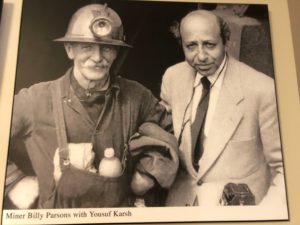
“… world’s greatest portrait photographer…”
“Imagine how much Yousuf Karsh would have charged to film your town? Now look at the photos a little closer, because it looks like .10 cents an hour went an awfully long way back then. Undoubtedly, many of the homes are in rough shape right now but look at the magnificent architecture and their enormity. These are finer than most any home built in North American during the early 1900’s.”
“Did you see the number of vehicles Karsh captured? On an island! With nowhere to drive! A sinful luxury best ascribed as conspicuous consumption.”
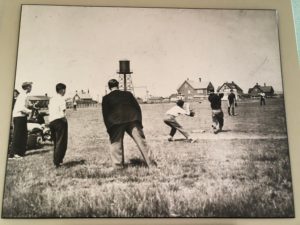
“… look at the pictures closely…”
“There are photos of grown men playing baseball on Bell Island – unheard of anywhere in Newfoundland except the American bases. No one else could afford recreational time – let alone the equipment to play like they did on ‘Bell Island’ where it was as good as the Major Leagues. Even the farms ‘Karsh’ photographed in ‘Lance Cove’ were beautifully terraced and so well kept they remind us of more renowned agricultural regions in Tuscany or the Napa Valley.”
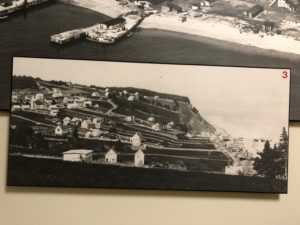
“… beautifully terraced farmlands…”
“No doubt life was hard on ‘Bell Island‘ – but it was challenging for everyone in those days and many endured much worse. The reality is, Bell Island exhibited an enviable lifestyle and a beautiful community that should be celebrated – not only for posterity, but future generations who could be encouraged to believe in their self worth and an ability to build a more hopeful future.”

